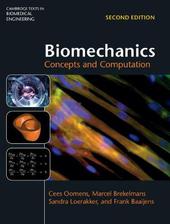
|
Biomechanics: Concepts and Computation
Hardback
Main Details
| Title |
Biomechanics: Concepts and Computation
|
| Authors and Contributors |
By (author) Cees Oomens
|
|
By (author) Marcel Brekelmans
|
|
By (author) Sandra Loerakker
|
|
By (author) Frank Baaijens
|
| Series | Cambridge Texts in Biomedical Engineering |
|---|
| Physical Properties |
| Format:Hardback | | Pages:420 | | Dimensions(mm): Height 253,Width 193 |
|
| ISBN/Barcode |
9781107163720
|
| Classifications | Dewey:571.43 |
|---|
| Audience | | Tertiary Education (US: College) | | Professional & Vocational | |
|---|
| Edition |
2nd Revised edition
|
| Illustrations |
Worked examples or Exercises; 6 Tables, black and white; 30 Halftones, black and white; 250 Line drawings, black and white
|
|
Publishing Details |
| Publisher |
Cambridge University Press
|
| Imprint |
Cambridge University Press
|
| Publication Date |
8 February 2018 |
| Publication Country |
United Kingdom
|
Description
Thoroughly revised and updated for the second edition, this comprehensive textbook integrates basic and advanced concepts of mechanics with numerical methods and biomedical applications. Coverage is expanded to include a complete introduction to vector and tensor calculus, and new or fully updated chapters on biological materials and continuum mechanics, motion, deformation and rotation, and constitutive modelling of solids and fluids. Topics such as kinematics, equilibrium, and stresses and strains are also included, as well as the mechanical behaviour of fibres and the analysis of one-dimensional continuous elastic media. Numerical solution procedures based on the Finite Element Method are presented, with accompanying MATLAB-based software and dozens of new biomedical engineering examples and exercises allowing readers to practise and improve their skills. Solutions for instructors are also available online. This is the definitive guide for both undergraduate and graduate students taking courses in biomechanics.
Author Biography
Cees Oomens is Full Professor in Biomechanics of Soft Tissues at the Technische Universiteit Eindhoven, The Netherlands. Marcel Brekelmans is an Associate Professor in Continuum Mechanics at the Technische Universiteit Eindhoven, The Netherlands. Sandra Loerakker is Assistant Professor in Modelling in Mechanobiology at the Technische Universiteit Eindhoven, The Netherlands, where she also teaches courses in numerical methods for solving continuum mechanics problems. Frank Baaijens is Full Professor in Soft Tissue Biomechanics and Tissue Engineering at the Technische Universiteit Eindhoven, The Netherlands. He is currently the university's Rector Magnificus.
Reviews'The increased number of exercises and examples used to bring the lectures alive and to illustrate the theory in biomedical applications make this second edition of the book Biomechanics: Concepts and Computation definitely the reference to teach classical concepts of mechanics and computational modelling techniques for biomedical engineers at Bachelor level. The authors from Eindhoven University of Technology belong to one of the most prestigious Departments of Biomedical Engineering around the world, with a well-recognized expertise in Soft Tissue Biomechanics and Tissue Engineering. I have no hesitation in recommending that book that should be a prerequisite for any student studying biomechanics.' Yohan Payan, Director of Research at Centre National de la Recherche Scientifique (CNRS), Universite Grenoble Alpes 'A comprehensive textbook for learning all important concepts of biomechanics and their possible applications in sports and medicine. Students will enjoy the opportunity of learning computational modeling in biomechanics from scratch, needing only basic mathematical background. Instructors will appreciate the endless source of problems all resulting from successful experiences of teaching in the authors' career. Definitely recommended in every library.' Stephane Avril, Ecole des Mines, St Etienne 'Biomechanics: Concepts and Computation remains one of the strongest textbooks ever written in the field of biomechanical education. The theory in the book is thorough and rigorous, and is extremely well illustrated with numerous excellent exercises. I find the chapters describing numerical implementation and finite element formulations especially useful for translating the theory of tissue mechanics to bioengineering practice. I am using this book routinely in my undergraduate and graduate courses and will continue to do so with this second edition.' Amit Gefen, Tel Aviv University, Israel
|